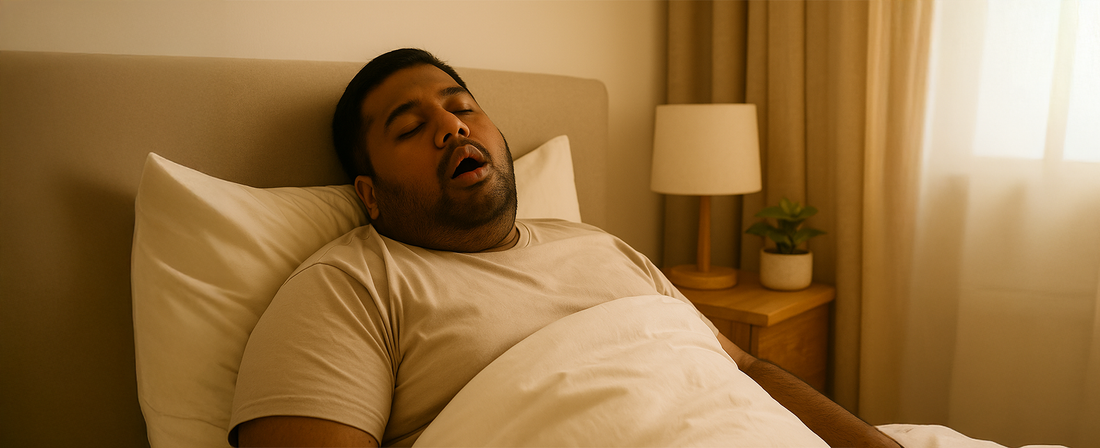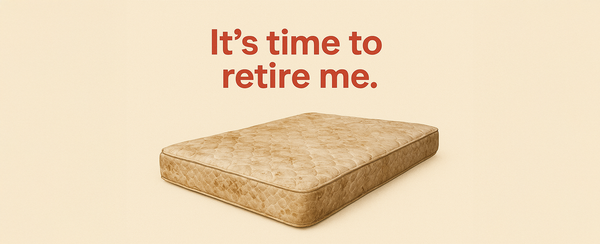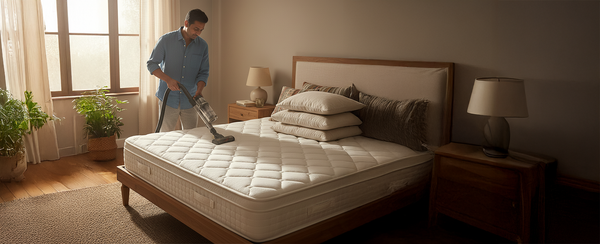Hidden Dangers At Night: Sleep Apnea & Snoring

Ever been woken up by someone’s loud snoring? Or perhaps it is your snoring that keeps everyone else awake?
Either way, there’s snoring and then there’s snoring that’s accompanied by interruptions in breathing, which is a sign of something far more serious — sleep apnea.
Across the world, millions live with this underdiagnosed condition. India is no exception.

How Big Is the Problem of Sleep Apnea in India?
A recent systematic review and meta-analysis estimates that about 104 million working-age Indians suffer from obstructive sleep apnea (OSA), with ~47 million having moderate-to-severe OSA.
Another meta-analysis puts the prevalence of moderate-to-severe OSA (Apnea Hypopnea Index, AHI ≥15 events/hour) at around 5% (95% CI: 2–8%) among Indian adults. On the other hand, urban studies (for example, those in South Delhi using the STOP-BANG questionnaire) show that a large majority are at low risk, but around 6–7% fall into high-risk categories.
If these numbers are startling, read on to find out whether you are at risk.
What Is Sleep Apnea?
Sleep apnea is a disorder in which breathing repeatedly stops and starts during sleep.
There are two main types:
- Obstructive Sleep Apnea (OSA): the most common kind — occurs when throat muscles relax and block the airway, perhaps even due to physical obstructions. The flow of air is reduced or stopped, causing interrupted breathing.
- Central Sleep Apnea (CSA): less common — here, the brain doesn’t send proper signals to the breathing muscles.
Some people may even suffer from a version that is a combination of the two.
What Causes It? What are the risk factors?
There are many interlocking causes of Sleep Apnea. These include:
- Obesity / Excess fat deposition: especially around the neck, tongue or throat tissues. Fat can constrict or collapse the upper airway during sleep.
- Anatomical features: a thick neck, large tonsils or adenoids, a long soft palate, a tongue that falls back during sleep, or a narrow airway.
- Age: risk increases with age. Changes in airway elasticity, increased fat deposition, and reduced muscle tone during sleep contribute to these changes.
- Sex / Gender: men are more likely to develop OSA compared to women; after menopause, women’s risk rises.
- Lifestyle factors: alcohol consumption, smoking, sleeping on the back, and sedatives that relax throat muscles. Nasal congestion or allergies worsen obstruction.
- Other medical conditions: hypothyroidism, polycystic ovarian syndrome, and hormonal imbalances. Also, comorbidities like hypertension, metabolic syndrome, and heart disease increase risks.

Symptoms
How do you know if you’re silently suffering from Sleep Apnea? Snoring is often an early signal. Loud, continuous snoring typically occurs when the airway is narrow or collapsing slightly, even if sleep apnea is not yet severe.
Gasping, choking or breaks between breaths during sleep are symptoms of a more serious condition. Other symptoms include:
- Excessive sleepiness during the daytime, including feeling fatigued and experiencing headaches in the morning.
- Poor concentration, memory lapses, irritability and mood swings as a result of improper sleep.
- Dry mouth or sore throat upon waking up.
If left untreated, OSA and CSA can increase the risks of cardiovascular diseases: hypertension, arrhythmias, stroke, heart attacks and a host of other health problems.
Prevention Is Better Than Cure
There are several preventive and treatment measures, including simple lifestyle changes and medical options.
- Losing even a moderate amount of weight (5–10%): can reduce or sometimes resolve mild to moderate OSA.
- Sleeping on the side: instead of the back can help prevent the tongue or soft palate from blocking the airway.
- Avoid alcohol & sedatives before bed: especially those that relax throat muscles.
- Treat nasal congestion/allergies: so breathing through the nose is easier.
- Improve sleep hygiene: establish a consistent bedtime, maintain a cool, dark room, and avoid heavy meals just before sleep.
- Quit smoking: reduces inflammation in the airway.
- Medical interventions: including Continuous Positive Airway Pressure (CPAP), oral appliances, and more.
- Regular screening: especially in people with risk factors — overweight, snorers, those with cardiovascular disease, diabetes, etc. In India, simple questionnaires like STOP-BANG or the Berlin Questionnaire are often used in clinics.

If you, or someone you know, snores like a train, it could be Sleep Apnea. It’s a severe disorder that disrupts rest, oxygen levels, mood, memory, and metabolic and cardiovascular health. Early recognition, prevention, and treatment are urgent.
If you snore loudly, wake up gasping, or feel tired during the day despite getting adequate sleep, don’t shrug it off. Talk to a physician or sleep specialist. It might just mean reclaiming healthier nights, sharper days, and a stronger future.










